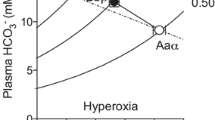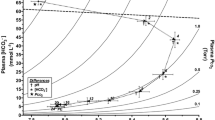Abstract
The armored catfish Pterygoplichthys pardalis tolerates environmental hypercarbia, high partial pressures of CO2 (\(P_{{{\text{CO}}_{ 2} }}\)), by preferentially protecting intracellular pH (pHi) in the face of extracellular acidosis. This response is associated with ionic changes which may disrupt contractility in cardiac muscle, and it is not known whether acclimation to hypercarbia provides protection against these changes. We studied the influence of different \(P_{{{\text{CO}}_{ 2} }}\) acclimation histories on cardiac muscle function using isometrically contracting ventricular strip preparations. Fish were held for >4 months at 21 mmHg \(P_{{{\text{CO}}_{ 2} }}\) and then exposed to normocarbia (6 mmHg \(P_{{{\text{CO}}_{ 2} }}\)) for either 15 h or 5–6 days. Acclimation to chronic hypercarbia eliminated the negative inotropic effects of in vitro hypercarbia, decreased extracellular Ca2+ sensitivity, and reduced maximum pacing frequency in ventricular strip preparations. Fish acclimated to chronic hypercarbia also exhibited hepatic glycogen and plasma glucose accumulation, and lower plasma lactate levels compared to fish acclimated to normocarbia for 5–6 days. We suggest chronic hypercarbia may induce cardiac remodeling to protect contractility and reduce the energetic demands of pHi regulation. The activation of HCO3 − synthesis pathways may decrease glucose utilization and enhance carbohydrate stores, potentially providing protection against hypoxia, a stressor frequently encountered in conjunction with hypercarbia in the Amazon.









Similar content being viewed by others
References
Almeida-Val, V. M. F., Chippari Gomes, A. R. & N. P. Lopes, 2006. Metabolic and physiological adjustments to low oxygen and high temperature in fishes of the Amazon. In Val, A. L., V. M. F. Almeida-Val & D. J. Randall (eds), The Physiology of Tropical Fishes, Vol. 21. Elsevier, San Diego: 443–491.
Bailey, J. R. & W. R. Driedzic, 1990. Enhanced maximum frequency and force development of fish hearts following temperature acclimation. Journal of Experimental Biology 149: 239–254.
Bailey, J. R., D. H. Sephton & W. R. Driedzic, 1991. Impact of acute temperature change on performance and metabolism of pickerel (Esox niger) and eel (Anguilla rostrata) hearts. Physiological Zoology 64: 697–716.
Bailey, J. R., T. Barter & W. R. Driedzic, 2000. Maintenance of resting tension in the American eel (Anguilla rostrata L.) heart is dependent upon exogenous fuel and the sarcoplasmic reticulum. Journal of Experimental Zoology 286: 707–717.
Baker, D. W. & C. J. Brauner, 2012. Metabolic changes associated with acid–base regulation during hypercarbia in the CO2-tolerant chondrostean, white sturgeon (Acipenser transmontanus). Comparative Biochemistry and Physiology A 161: 61–68.
Baker, D. W., K. T. Huynh, J. M. Wilson, J. D. Morgan & C. J. Brauner, 2009. Complete intracellular pH protection during extracellular pH depression is associated with hypercarbia tolerance in white sturgeon, Acipenser transmontanus. American Journal of Physiology 296: R1868–R1880.
Baker, D. W., L. M. Hanson, A. P. Farrell & C. J. Brauner, 2011. Exceptional CO2 tolerance in white sturgeon (Acipenser transmontanus) is associated with protection of maximum cardiac performance during hypercapnia in situ. Physiological and Biochemical Zoology 84: 239–248.
Brauner, C. J. & D. W. Baker, 2009. Patterns of acid-base regulation during exposure to hypercarbia in fishes. In Glass M. L. & S. C. Wood (eds), Cardio-Respiratory Control in Vertebrates: Comparative and Evolutionary Aspects, Springer-Verlag, Berlin: 43–64.
Brauner, C. J., T. Wang, Y. Wang, J. G. Richards, R. J. Gonzalez, N. J. Bernier, W. Xi, M. Patrick & A. L. Val, 2004. Limited extracellular but complete intracellular acid–base regulation during short-term environmental hypercapnia in the armoured catfish, Liposarcus pardalis. Journal of Experimental Biology 207: 3381–3390.
Clow, K. A., K. J. Rodnick, T. J. MacCormack & W. R. Driedzic, 2004. The regulation and importance of glucose uptake in the isolated Atlantic cod heart: rate-limiting steps and effects of hypoxia. Journal of Experimental Biology 207: 1865–1874.
Curthoys, N. P. & O. W. Moe, 2014. Proximal tubule function and response to acidosis. Clinical Journal of the American Society of Nephrology 9: 1627–1638.
Dhar-Chowdhury, P., B. Malester, P. Rajacic & W. A. Coetzee, 2007. The regulation of ion channels and transporters by glycolytically derived ATP. Cellular and Molecular Life Sciences 64: 3069–3083.
Driedzic, W. R. & H. Gesser, 1985. Ca2+ protection from the negative inotropic effect of contraction frequency on teleost hearts. Journal of Comparative Physiology B 156: 135–142.
Driedzic, W. R. & H. Gesser, 1994. Energy metabolism and contractility in ectothermic vertebrate hearts: hypoxia, acidosis, and low temperature. Physiological Reviews 74: 221–257.
Garciarena, C. D., J. B. Youm, P. Swietach & R. D. Vaughan-Jones, 2013. H+-activated Na+ influx in the ventricular myocyte couples Ca2+-signalling to intracellular pH. Journal of Molecular and Cellular Cardiology 61: 51–59.
Géry, J., 1984. The fishes of Amazonia. In Sioli, H. (ed.), The Amazon. Limnology and Landscape Ecology of a Mighty Tropical River and Its Basin. Dr W. Junk Publishers, Dordrecht: 353–370.
Hanson, L. M., D. W. Baker, L. J. Kuchel, A. P. Farrell, A. L. Val & C. J. Brauner, 2009. Intrinsic mechanical properties of the perfused armoured catfish heart with special reference to the effects of hypercapnic acidosis on maximum cardiac performance. Journal of Experimental Biology 212: 1270–1276.
Harter, T. S., R. B. Shartau, D. W. Baker, D. C. Jackson, A. L. Val & C. J. Brauner, 2014. Preferential intracellular pH regulation represents a general pattern of pH homeostasis during acid–base disturbances in the armoured catfish, Pterygoplichthys pardalis. Journal of Comparative Physiology B 184: 709–718.
Hochachka, P. W., L. T. Buck, C. J. Doll & S. C. Land, 1996. Unifying theory of hypoxia tolerance: molecular/metabolic defense and rescue mechanisms for surviving oxygen lack. Proceedings of the National Academy of Sciences USA 93: 9493–9498.
Hove-Madsen, L., A. Llach, G. F. Tibbits & L. Tort, 2003. Triggering of sarcoplasmic reticulum Ca2+ release and contraction by reverse mode Na+/Ca2+ exchange in trout atrial myocytes. American Journal of Physiology 284: R1330–R1339.
Kramer, D. L., C. C. Lindsey, G. E. E. Moodie & E. D. Stevens, 1978. The fishes and the aquatic environment of the central Amazon Basin, with particular reference to respiratory patterns. Canadian Journal of Zoology 56: 717–729.
Layland, J. Y. & J. D. Altringham, 1995. The effect of cycle frequency on the power output of rat papillary muscles in vitro. Journal of Experimental Biology 198: 1035–1043.
MacCormack, T. J., R. S. McKinley, R. Roubach, V. M. F. Almeida-Val, A. L. Val & W. R. Driedzic, 2003a. Changes in ventilation, metabolism, and behaviour, but not bradycardia, contribute to hypoxia survival in two species of Amazonian armoured catfish. Canadian Journal of Zoology 81: 272–280.
MacCormack, T. J., J. R. Treberg, V. M. F. Almeida-Val, A. L. Val & W. R. Driedzic, 2003b. Mitochondrial KATP channels and sarcoplasmic reticulum influence cardiac force development under anoxia in the Amazonian armored catfish Liposarcus pardalis. Comparative Biochemistry and Physiology A 134: 441–448.
MacCormack, T. J., J. M. Lewis, V. M. F. Almeida-Val, A. L. Val & W. R. Driedzic, 2006. Carbohydrate management, anaerobic metabolism, and adenosine levels in the armoured catfish, Liposarcus pardalis (Castelnau), during hypoxia. Journal of Experimental Zoology 305A: 363–375.
McKenzie, D. J., M. Piccolella, A. Z. Dalla Valle, E. W. Taylor, C. L. Bolis & J. F. Steffensen, 2003. Tolerance of chronic hypercapnia by the European eel Anguilla anguilla. Journal of Experimental Biology 206: 1717–1726.
Pörtner, H. O., C. Bock & A. Reipschläger, 2000. Modulation of the cost of pHi regulation during metabolic depression: a (31)P-NMR study in invertebrate (Sipunculus nudus) isolated muscle. Journal of Experimental Biology 203: 2417–2428.
Rantin, F. T., H. Gesser, A. L. Kalinin, C. D. R. Guerra, J. C. De Freitas & W. R. Driedzic, 1998. Heart performance, Ca2+ regulation and energy metabolism at high temperatures in Bathygobius soporator, a tropical marine teleost. Journal of Thermal Biology 23: 31–39.
Raymond, J. A. & W. R. Driedzic, 1997. Amino acids are a source of glycerol in cold-acclimatized rainbow smelt. Comparative Biochemistry and Physiology B 118: 387–393.
Sepp, M., N. Sokolova, S. Jugai, M. Mandel, P. Peterson & M. Vendelin, 2014. Tight coupling of Na+/K+-ATPase with glycolysis demonstrated in permeabilized rat cardiomyocytes. PLOS ONE 9: e99413.
Shiels, H. A., D. A. Santiago & G. l. J. Galli, 2010. Hypercapnic acidosis reduces contractile function in the ventricle of the armored catfish, Pterygoplichthys pardalis. Physiological and Biochemical Zoology 83: 366–375.
Soares, M. G. M., N. A. Menezes & W. J. Junk, 2006. Adaptations of fish species to oxygen depletion in a central Amazonian floodplain lake. Hydrobiologia 568: 353–367.
Tibbits, G. F., K. D. Philipson & H. Kashihara, 1992. Characterization of myocardial Na+-Ca2+ exchange in rainbow trout. American Journal of Physiology 262: C411–C417.
Tseng, Y. Y., M. Y. Hu, M. Stumpp, L. Y. Lin, F. Melzner & P. P. Hwang, 2013. CO2-driven seawater acidification differentially affects development and molecular plasticity along life history of fish (Oryzias latipes). Comparative Biochemistry and Physiology A 165: 119–130.
Val, A. L., 1995. Oxygen transfer in fish: morphological and molecular adjustments. Brazilian Journal of Medical and Biological Research 28: 1119–1127.
Vornanen, M., 1999. Na+/Ca2+ exchange current in ventricular myocytes of fish heart: contribution to sarcolemmal Ca2+ influx. Journal of Experimental Biology 202: 1763–1775.
Acknowledgements
TJM and WRD were supported by Natural Sciences and Engineering Research Council of Canada Discovery grants. WRD holds the Canada Research Chair in Marine Bioscience. JLR was supported by a travel grant from Memorial University of Newfoundland. The experiments were supported by INCT ADAPTA (CNPq/FAPEAM) and by the Brazilian National Institute for Research in the Amazon (INPA) grants to ALV. ALV holds a research fellowship from the Brazilian National Counsel of Technological and Scientific Development (CNPq). The authors thank Nazare De Paula Silva and the staff at LEEM for technical assistance, Connie Short for biochemical analyses, and Maria Thistle for statistical advice.
Author information
Authors and Affiliations
Corresponding author
Additional information
Guest editors: Adalberto L. Val, Gudrun De Boeck & Sidinei M. Thomaz / Adaptation of Aquatic Biota of the Amazon
Rights and permissions
About this article
Cite this article
MacCormack, T.J., Robinson, J.L., Almeida-Val, V.M.F. et al. Acclimation to hypercarbia protects cardiac contractility and alters tissue carbohydrate metabolism in the Amazonian armored catfish Pterygoplichthys pardalis . Hydrobiologia 789, 91–106 (2017). https://doi.org/10.1007/s10750-015-2496-6
Received:
Revised:
Accepted:
Published:
Issue Date:
DOI: https://doi.org/10.1007/s10750-015-2496-6




